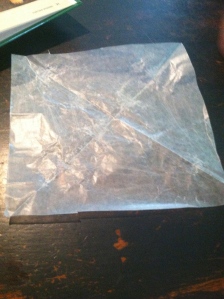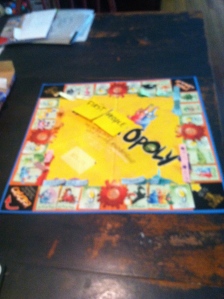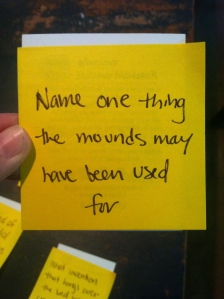 And…we’re back. It’s taken me awhile to 1) find the time to update the blog and 2) decide how I wanted to organize the blog this year. We have been marvelously busy. I have felt more comfortable taking risks this year with our routine and curriculum, which means things no longer neatly fall into clean weeks of unit themes that can be easily blogged and recorded. This took me a few weeks to adjust to–I am so used to exploring a new topic every week, and had developed a sense of how much we could bite off to finish on schedule. Now that we are using the Intellego Units, we have taken a deep dive approach. The pace is slower, the material is more detailed, and my preconceived ideas about how long it would take to learn a topic have been uprooted. Intellego estimates 40 hours to work through an entire unit study. I thought for sure we would roll through it faster than that. But soon I realized we needed to take our time with it–the beauty of these unit studies lies in their detail. Roaring through them was really not the point, especially since we have studied in a more broad way many of the subjects covered in the unit itself, and the purpose of choosing these was their well organized, in-depth look, allowing us a deeper dive into things we had taken an initial look at over the last 3 years. We just finished our very first Intellego Unit this week, about 6 weeks after we started it. Since we have been working on it about 3 days a week, about 2 hours a day, I suppose that does ultimately work out to about those 40 hours. This unit was American History I: Before the New Nation (3rd-5th grade), and consisted of three lengthy chapters. We have been supplementing it with books from the library, and activities we come up with. Between that, the other Intellego science unit Matt is teaching, language arts, two kinds of math, AJ’s newly discovered passion for reading excessively long chapter books, and the huge amount of classes and activities he is in, we are finally settling into a rhythm for the school year. So I now return to regular blogging. I have quite missed it, as I always feel a sense of accomplishment recording what we have learned. So now, our exploration into our first unit chapter: Life Before the Europeans. AJ’s one request when we decided to go with Intellego was that we still pick out lots of other books from the library to go along with it. And so we did:
And…we’re back. It’s taken me awhile to 1) find the time to update the blog and 2) decide how I wanted to organize the blog this year. We have been marvelously busy. I have felt more comfortable taking risks this year with our routine and curriculum, which means things no longer neatly fall into clean weeks of unit themes that can be easily blogged and recorded. This took me a few weeks to adjust to–I am so used to exploring a new topic every week, and had developed a sense of how much we could bite off to finish on schedule. Now that we are using the Intellego Units, we have taken a deep dive approach. The pace is slower, the material is more detailed, and my preconceived ideas about how long it would take to learn a topic have been uprooted. Intellego estimates 40 hours to work through an entire unit study. I thought for sure we would roll through it faster than that. But soon I realized we needed to take our time with it–the beauty of these unit studies lies in their detail. Roaring through them was really not the point, especially since we have studied in a more broad way many of the subjects covered in the unit itself, and the purpose of choosing these was their well organized, in-depth look, allowing us a deeper dive into things we had taken an initial look at over the last 3 years. We just finished our very first Intellego Unit this week, about 6 weeks after we started it. Since we have been working on it about 3 days a week, about 2 hours a day, I suppose that does ultimately work out to about those 40 hours. This unit was American History I: Before the New Nation (3rd-5th grade), and consisted of three lengthy chapters. We have been supplementing it with books from the library, and activities we come up with. Between that, the other Intellego science unit Matt is teaching, language arts, two kinds of math, AJ’s newly discovered passion for reading excessively long chapter books, and the huge amount of classes and activities he is in, we are finally settling into a rhythm for the school year. So I now return to regular blogging. I have quite missed it, as I always feel a sense of accomplishment recording what we have learned. So now, our exploration into our first unit chapter: Life Before the Europeans. AJ’s one request when we decided to go with Intellego was that we still pick out lots of other books from the library to go along with it. And so we did: 




 We studied Native Americans in Kindergarten (which was great fun, and resulted in a tepee being built upstairs in the schoolroom). But this unit started with the first people crossing the land bridge Beringia into what would later be known as North America.
We studied Native Americans in Kindergarten (which was great fun, and resulted in a tepee being built upstairs in the schoolroom). But this unit started with the first people crossing the land bridge Beringia into what would later be known as North America.  Somehow AJ knew all of this already (“It’s in a book I read…”), but he knew much less about what came after that–namely, the migration of specific tribes for specific reasons. This is where I really got hooked on the Intellego. When I was researching these unit studies, there were not many reviews by homeschoolers about them. What I was hoping for was the detail, the chronology, the perspective of how seemingly separate events were connected (the story of history), as well as great online links, activities, and ideas. In short, something that was not 2-dimensional, but alive and engaging. I have been impressed by the story told by these units–the different perspectives, the depth of discussion, and the critical thinking they promote (discussion questions about why certain tribes would have needed to live in certain places, debate about what may have happened to tribes that mysteriously disappeared, etc). I am not a universal fan of some of the links embedded in the units, some were marvelous and others were very dry and overly detailed, but that’s where I think you have to steer according to the kid’s interests and level. I readily skipped over very long, textbook like detail and let him spend all kinds of time on the interactive activity sites and videos. The chapters all start with a KWL chart. AJ hates KWL charts. I might have overdone these in a teensy way when we first started homeschooling–now when he sees one he has a visceral negative reaction. So we skipped over that and just had a nice discussion of what we Knew. This unit took us on a journey of the Yupik, the Mississippi Mound Builders, the Cliff Dwellers, the Ojibwa, and the Plains Indians. The story behind each of the groups–what took them to where they settled, and how where they lived influenced how and what they hunted, the climate challenges, and what they invented–was fascinating. Yupik: Also known as Eskimos. AJ enjoyed the Smithsonian activity included in this section, as well as the folk stories about the role of the Raven in the creation of the first people. Mississippi Mound Builders: I have memories of going to Effigy Mounds when I was growing up, and we have two different mound sites close to where we live (neither of which we have been able to visit yet!). The story of the mounds (and the lack of agreement of what the mounds were actually for) was fascinating, and we are planning a field trip there soon (hopefully before it gets too cold!) AJ and one of our college students who come out to the Schoolhouse attempted to make Clay Pots during this part of the unit, and ran into all kinds of struggles finding a kind of clay that would work. They tried Crayola air dry clay, which crumbled, and then some Sculpty, which dried instantly. Leave me a comment with some child friendly clay pot clay if you have any good suggestions–we never did master those clay pots. There were good, deep discussion questions on this unit-for example, a discussion of the ethical considerations of excavating the mounds. Anasazi: The Cliff Dwellers. There is a good bit of mystery on the Anasazi, ancestors of the Pueblo people. We read a few books to go with this unit, and are still debating what might have happened to these people… Ojibwa: Moving north, these people lived on the Eastern Woodlands. AJ’s favorite part of this was making a dream catcher (again, with one of our students) to hang over his bed:
Somehow AJ knew all of this already (“It’s in a book I read…”), but he knew much less about what came after that–namely, the migration of specific tribes for specific reasons. This is where I really got hooked on the Intellego. When I was researching these unit studies, there were not many reviews by homeschoolers about them. What I was hoping for was the detail, the chronology, the perspective of how seemingly separate events were connected (the story of history), as well as great online links, activities, and ideas. In short, something that was not 2-dimensional, but alive and engaging. I have been impressed by the story told by these units–the different perspectives, the depth of discussion, and the critical thinking they promote (discussion questions about why certain tribes would have needed to live in certain places, debate about what may have happened to tribes that mysteriously disappeared, etc). I am not a universal fan of some of the links embedded in the units, some were marvelous and others were very dry and overly detailed, but that’s where I think you have to steer according to the kid’s interests and level. I readily skipped over very long, textbook like detail and let him spend all kinds of time on the interactive activity sites and videos. The chapters all start with a KWL chart. AJ hates KWL charts. I might have overdone these in a teensy way when we first started homeschooling–now when he sees one he has a visceral negative reaction. So we skipped over that and just had a nice discussion of what we Knew. This unit took us on a journey of the Yupik, the Mississippi Mound Builders, the Cliff Dwellers, the Ojibwa, and the Plains Indians. The story behind each of the groups–what took them to where they settled, and how where they lived influenced how and what they hunted, the climate challenges, and what they invented–was fascinating. Yupik: Also known as Eskimos. AJ enjoyed the Smithsonian activity included in this section, as well as the folk stories about the role of the Raven in the creation of the first people. Mississippi Mound Builders: I have memories of going to Effigy Mounds when I was growing up, and we have two different mound sites close to where we live (neither of which we have been able to visit yet!). The story of the mounds (and the lack of agreement of what the mounds were actually for) was fascinating, and we are planning a field trip there soon (hopefully before it gets too cold!) AJ and one of our college students who come out to the Schoolhouse attempted to make Clay Pots during this part of the unit, and ran into all kinds of struggles finding a kind of clay that would work. They tried Crayola air dry clay, which crumbled, and then some Sculpty, which dried instantly. Leave me a comment with some child friendly clay pot clay if you have any good suggestions–we never did master those clay pots. There were good, deep discussion questions on this unit-for example, a discussion of the ethical considerations of excavating the mounds. Anasazi: The Cliff Dwellers. There is a good bit of mystery on the Anasazi, ancestors of the Pueblo people. We read a few books to go with this unit, and are still debating what might have happened to these people… Ojibwa: Moving north, these people lived on the Eastern Woodlands. AJ’s favorite part of this was making a dream catcher (again, with one of our students) to hang over his bed:  Impressive, huh? It was a kit from Hobby Lobby. Plains Indians: This took us on an overview of the many tribes living in the plains prior to the arrival of the first European explorers and the different kinds of homes they built and why. We did a few other fun activities during this chapter as well, including making a drum (coffee can, old school), painting rocks, and an odd but interesting activity involving folding and biting wax paper to make patterns and indentations (this was in one of our books):
Impressive, huh? It was a kit from Hobby Lobby. Plains Indians: This took us on an overview of the many tribes living in the plains prior to the arrival of the first European explorers and the different kinds of homes they built and why. We did a few other fun activities during this chapter as well, including making a drum (coffee can, old school), painting rocks, and an odd but interesting activity involving folding and biting wax paper to make patterns and indentations (this was in one of our books):




 At the end of the chapter, there is no shortage of reflection activities and questions–designed for every kind of learner. We opted to go straight for the big finish–creating our own board game on all the tribes we had learned about. Technically you are supposed to use Monopoly as the basis for this, but I couldn’t exactly FIND our Monopoly at that particular time, so we used a Monopoly knockoff instead, and it worked fine. I ended up making this up as I went, writing some clues and questions, improvising categories, etc, as I wanted this to be more like a 45 minute finale, rather than a whole day long one:
At the end of the chapter, there is no shortage of reflection activities and questions–designed for every kind of learner. We opted to go straight for the big finish–creating our own board game on all the tribes we had learned about. Technically you are supposed to use Monopoly as the basis for this, but I couldn’t exactly FIND our Monopoly at that particular time, so we used a Monopoly knockoff instead, and it worked fine. I ended up making this up as I went, writing some clues and questions, improvising categories, etc, as I wanted this to be more like a 45 minute finale, rather than a whole day long one: 





 I must say, it won’t win any style prizes but it was a great way to test what AJ had learned over the prior weeks. I asked pretty hard questions, as the kid has a crazy good memory. Definitely going to use this idea again down the road! Next up: European Explorers. Columbus Day is tomorrow, so I might be motivated to start the next blog topic on that very topic (sneak preview: AJ thinks Columbus is a big jerk).
I must say, it won’t win any style prizes but it was a great way to test what AJ had learned over the prior weeks. I asked pretty hard questions, as the kid has a crazy good memory. Definitely going to use this idea again down the road! Next up: European Explorers. Columbus Day is tomorrow, so I might be motivated to start the next blog topic on that very topic (sneak preview: AJ thinks Columbus is a big jerk).
- Comment
- Reblog
-
Subscribe
Subscribed
Already have a WordPress.com account? Log in now.